Critical Management Perspectives: Organizational Change Report
VerifiedAdded on 2021/09/15
|16
|4381
|83
Report
AI Summary
This report delves into the profound impact of technology on organizations, examining how businesses must adapt to thrive in a rapidly evolving digital landscape. It explores the concept of organizational development and the critical emergent issue of technology's pervasive influence, particularly in the context of McDonald's service inefficiencies. The report identifies learning and change as critical success factors for navigating technological advancements. It then presents two key models of change management: Kurt Lewin's three-step model (Unfreeze, Change, Refreeze) and the Postmodernism theory, providing frameworks for understanding and implementing organizational change. The report also introduces the 'big idea' of Artificial Intelligence (AI) and its potential applications within organizations, concluding that embracing these changes is crucial for efficiency and success. The report emphasizes the need for continuous research and adaptation to stay ahead of technological advancements and build a competitive market position.
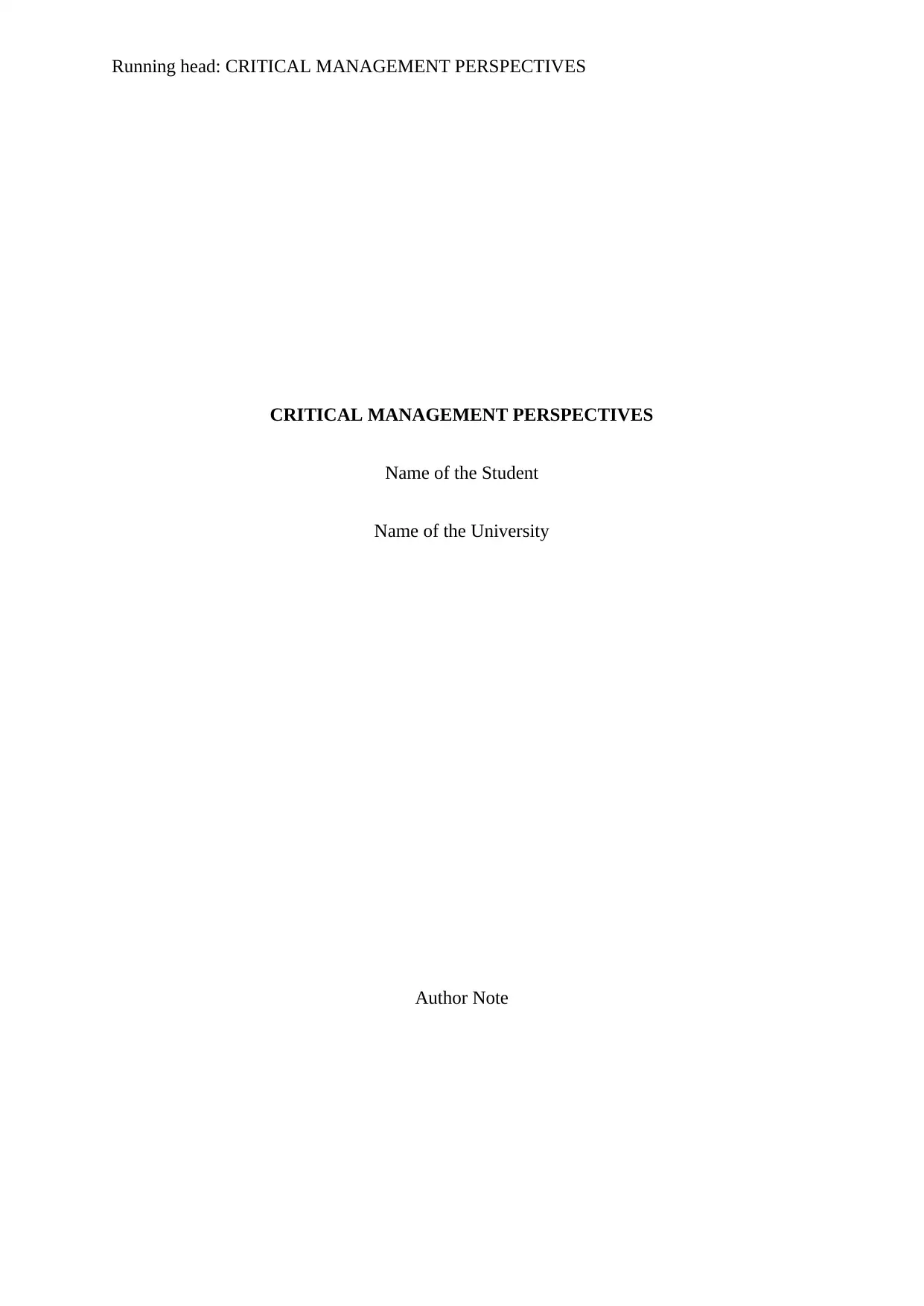
Running head: CRITICAL MANAGEMENT PERSPECTIVES
CRITICAL MANAGEMENT PERSPECTIVES
Name of the Student
Name of the University
Author Note
CRITICAL MANAGEMENT PERSPECTIVES
Name of the Student
Name of the University
Author Note
Paraphrase This Document
Need a fresh take? Get an instant paraphrase of this document with our AI Paraphraser
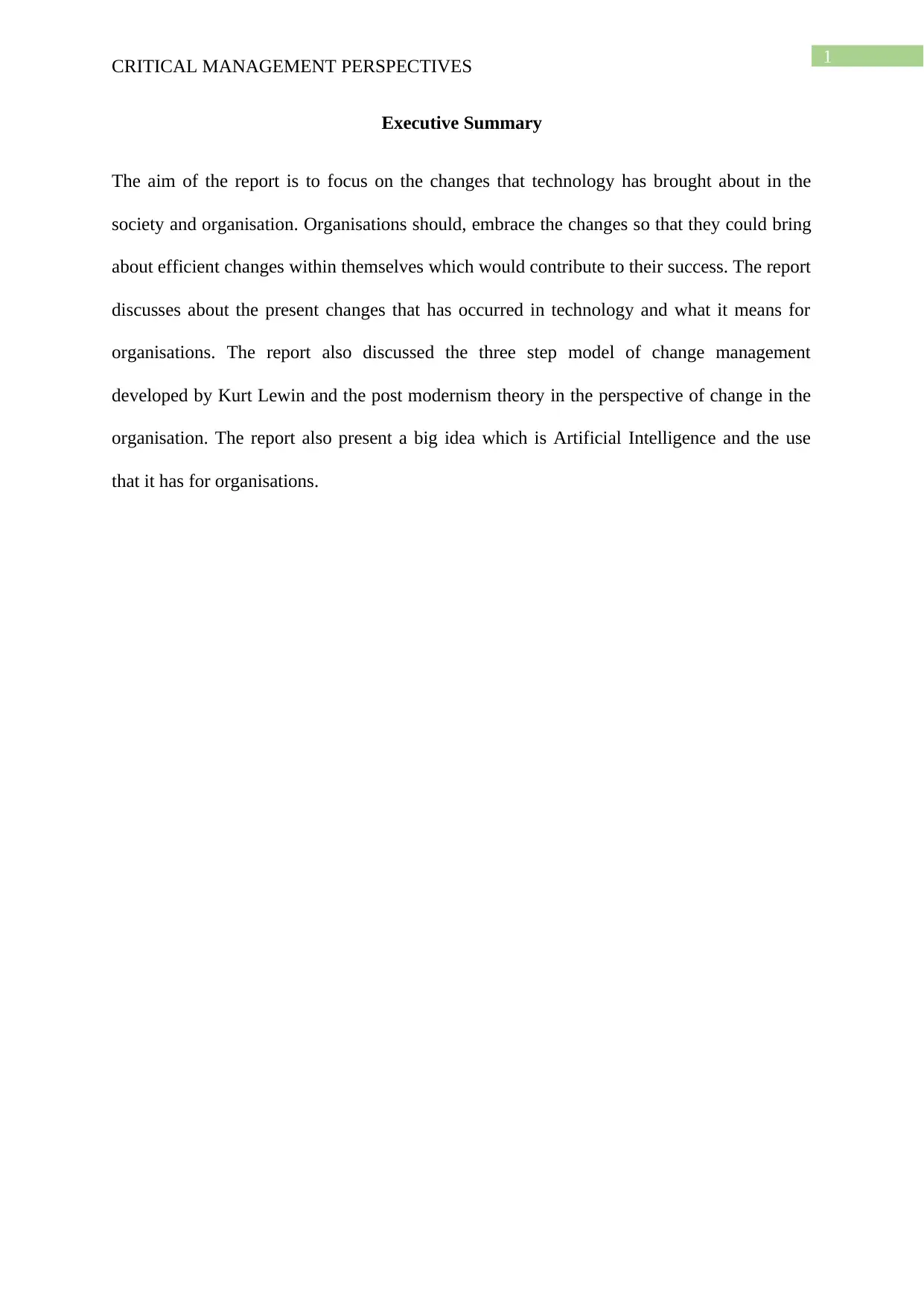
1
CRITICAL MANAGEMENT PERSPECTIVES
Executive Summary
The aim of the report is to focus on the changes that technology has brought about in the
society and organisation. Organisations should, embrace the changes so that they could bring
about efficient changes within themselves which would contribute to their success. The report
discusses about the present changes that has occurred in technology and what it means for
organisations. The report also discussed the three step model of change management
developed by Kurt Lewin and the post modernism theory in the perspective of change in the
organisation. The report also present a big idea which is Artificial Intelligence and the use
that it has for organisations.
CRITICAL MANAGEMENT PERSPECTIVES
Executive Summary
The aim of the report is to focus on the changes that technology has brought about in the
society and organisation. Organisations should, embrace the changes so that they could bring
about efficient changes within themselves which would contribute to their success. The report
discusses about the present changes that has occurred in technology and what it means for
organisations. The report also discussed the three step model of change management
developed by Kurt Lewin and the post modernism theory in the perspective of change in the
organisation. The report also present a big idea which is Artificial Intelligence and the use
that it has for organisations.
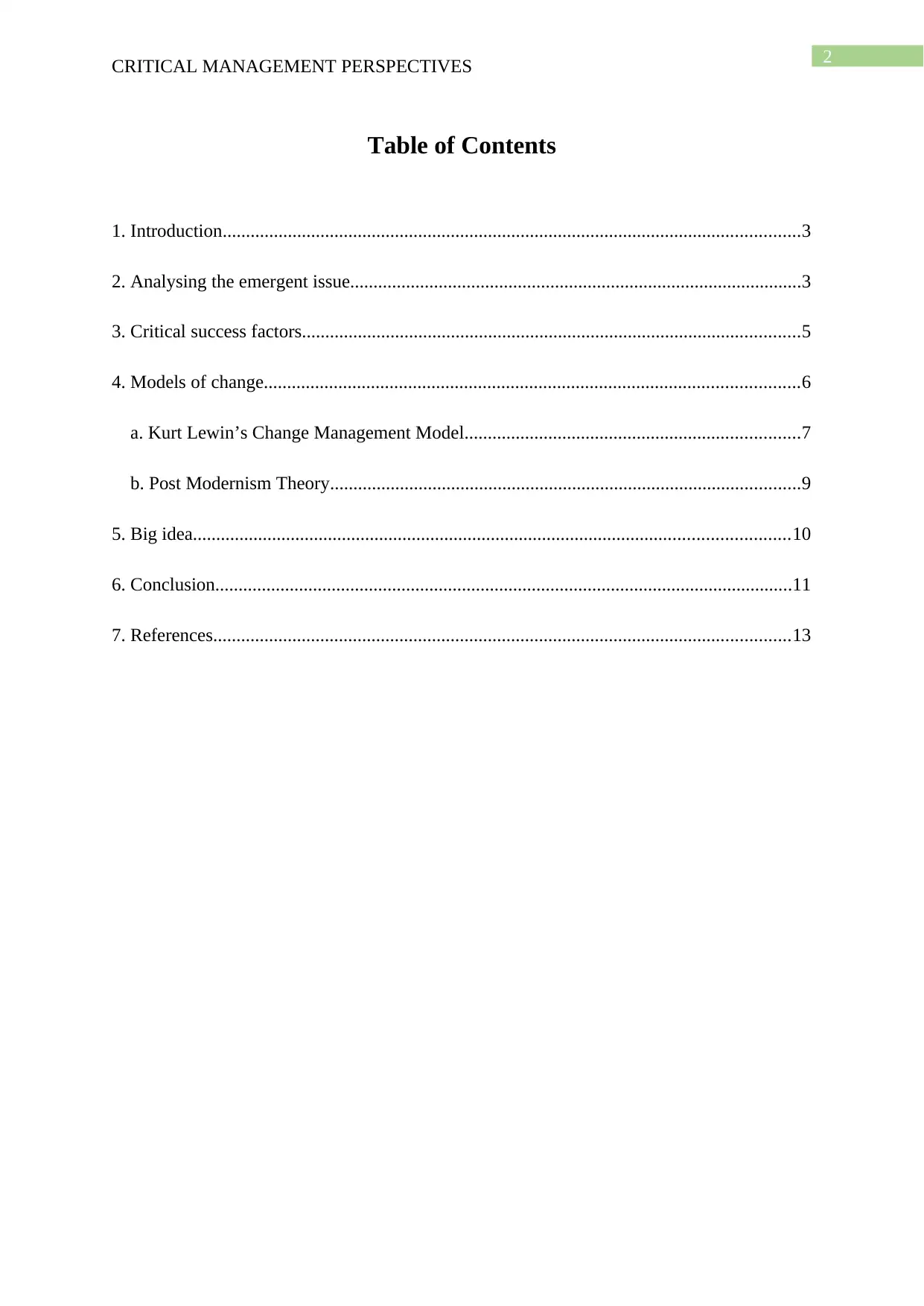
2
CRITICAL MANAGEMENT PERSPECTIVES
Table of Contents
1. Introduction............................................................................................................................3
2. Analysing the emergent issue.................................................................................................3
3. Critical success factors...........................................................................................................5
4. Models of change...................................................................................................................6
a. Kurt Lewin’s Change Management Model........................................................................7
b. Post Modernism Theory.....................................................................................................9
5. Big idea................................................................................................................................10
6. Conclusion............................................................................................................................11
7. References............................................................................................................................13
CRITICAL MANAGEMENT PERSPECTIVES
Table of Contents
1. Introduction............................................................................................................................3
2. Analysing the emergent issue.................................................................................................3
3. Critical success factors...........................................................................................................5
4. Models of change...................................................................................................................6
a. Kurt Lewin’s Change Management Model........................................................................7
b. Post Modernism Theory.....................................................................................................9
5. Big idea................................................................................................................................10
6. Conclusion............................................................................................................................11
7. References............................................................................................................................13
⊘ This is a preview!⊘
Do you want full access?
Subscribe today to unlock all pages.

Trusted by 1+ million students worldwide
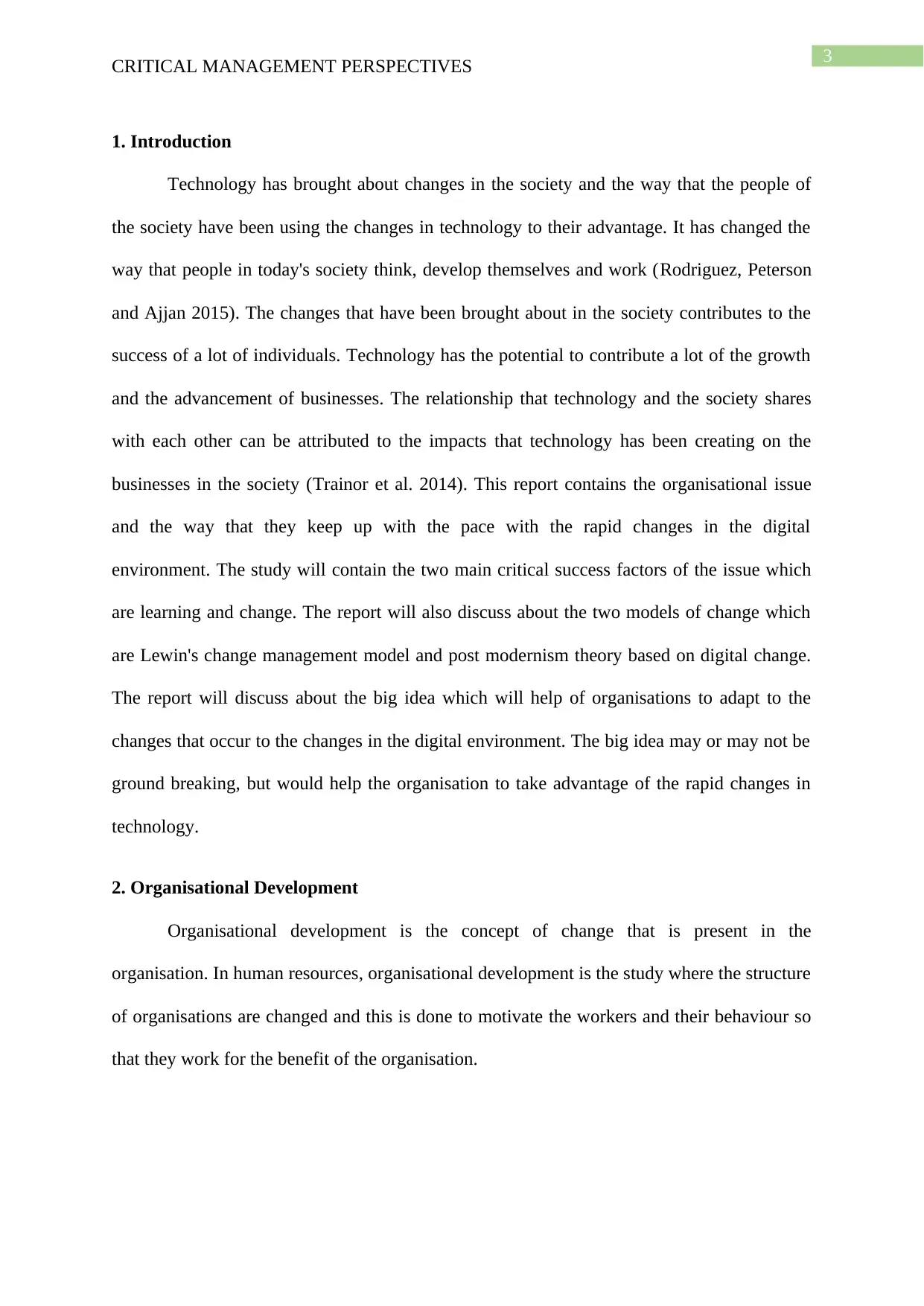
3
CRITICAL MANAGEMENT PERSPECTIVES
1. Introduction
Technology has brought about changes in the society and the way that the people of
the society have been using the changes in technology to their advantage. It has changed the
way that people in today's society think, develop themselves and work (Rodriguez, Peterson
and Ajjan 2015). The changes that have been brought about in the society contributes to the
success of a lot of individuals. Technology has the potential to contribute a lot of the growth
and the advancement of businesses. The relationship that technology and the society shares
with each other can be attributed to the impacts that technology has been creating on the
businesses in the society (Trainor et al. 2014). This report contains the organisational issue
and the way that they keep up with the pace with the rapid changes in the digital
environment. The study will contain the two main critical success factors of the issue which
are learning and change. The report will also discuss about the two models of change which
are Lewin's change management model and post modernism theory based on digital change.
The report will discuss about the big idea which will help of organisations to adapt to the
changes that occur to the changes in the digital environment. The big idea may or may not be
ground breaking, but would help the organisation to take advantage of the rapid changes in
technology.
2. Organisational Development
Organisational development is the concept of change that is present in the
organisation. In human resources, organisational development is the study where the structure
of organisations are changed and this is done to motivate the workers and their behaviour so
that they work for the benefit of the organisation.
CRITICAL MANAGEMENT PERSPECTIVES
1. Introduction
Technology has brought about changes in the society and the way that the people of
the society have been using the changes in technology to their advantage. It has changed the
way that people in today's society think, develop themselves and work (Rodriguez, Peterson
and Ajjan 2015). The changes that have been brought about in the society contributes to the
success of a lot of individuals. Technology has the potential to contribute a lot of the growth
and the advancement of businesses. The relationship that technology and the society shares
with each other can be attributed to the impacts that technology has been creating on the
businesses in the society (Trainor et al. 2014). This report contains the organisational issue
and the way that they keep up with the pace with the rapid changes in the digital
environment. The study will contain the two main critical success factors of the issue which
are learning and change. The report will also discuss about the two models of change which
are Lewin's change management model and post modernism theory based on digital change.
The report will discuss about the big idea which will help of organisations to adapt to the
changes that occur to the changes in the digital environment. The big idea may or may not be
ground breaking, but would help the organisation to take advantage of the rapid changes in
technology.
2. Organisational Development
Organisational development is the concept of change that is present in the
organisation. In human resources, organisational development is the study where the structure
of organisations are changed and this is done to motivate the workers and their behaviour so
that they work for the benefit of the organisation.
Paraphrase This Document
Need a fresh take? Get an instant paraphrase of this document with our AI Paraphraser
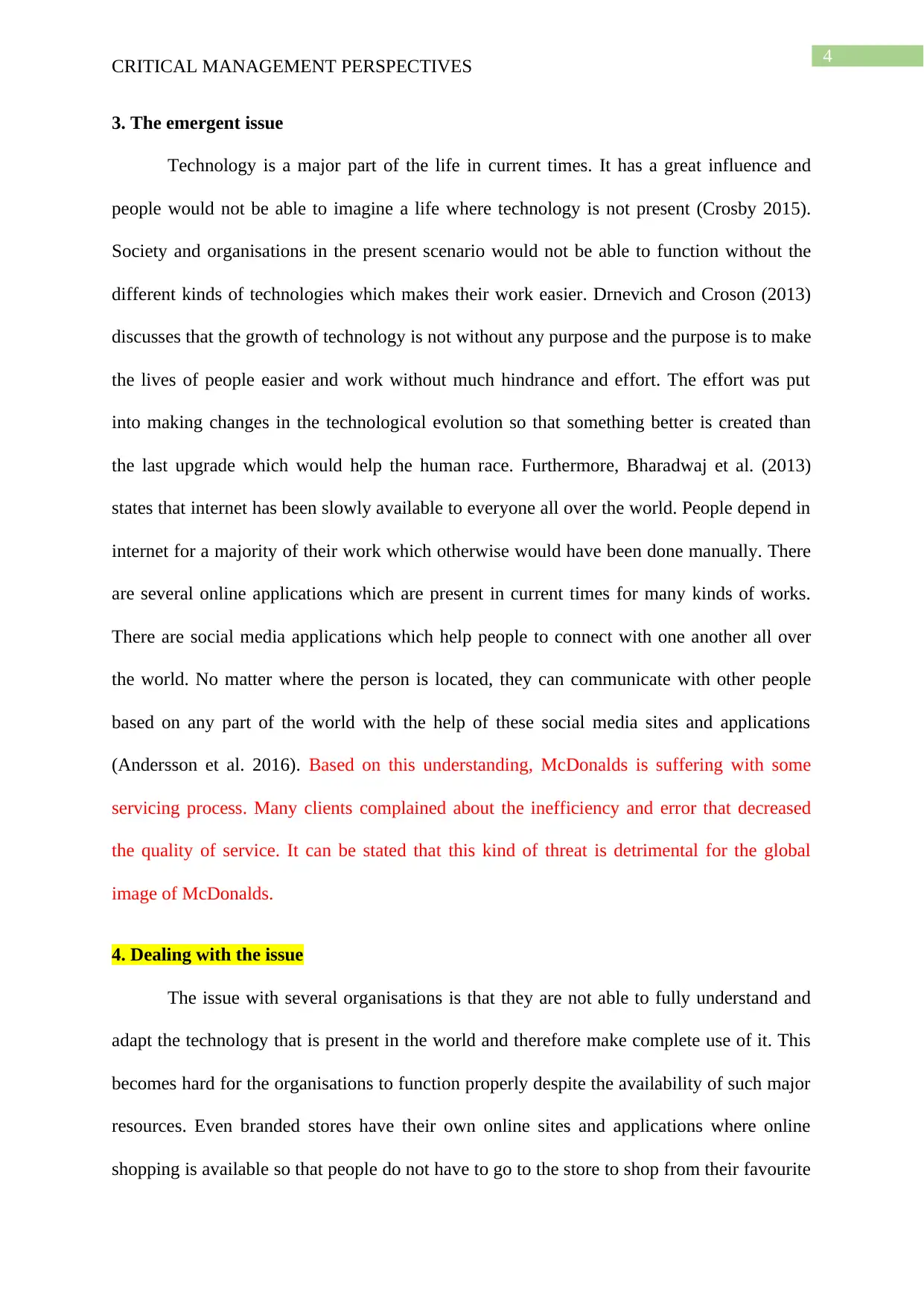
4
CRITICAL MANAGEMENT PERSPECTIVES
3. The emergent issue
Technology is a major part of the life in current times. It has a great influence and
people would not be able to imagine a life where technology is not present (Crosby 2015).
Society and organisations in the present scenario would not be able to function without the
different kinds of technologies which makes their work easier. Drnevich and Croson (2013)
discusses that the growth of technology is not without any purpose and the purpose is to make
the lives of people easier and work without much hindrance and effort. The effort was put
into making changes in the technological evolution so that something better is created than
the last upgrade which would help the human race. Furthermore, Bharadwaj et al. (2013)
states that internet has been slowly available to everyone all over the world. People depend in
internet for a majority of their work which otherwise would have been done manually. There
are several online applications which are present in current times for many kinds of works.
There are social media applications which help people to connect with one another all over
the world. No matter where the person is located, they can communicate with other people
based on any part of the world with the help of these social media sites and applications
(Andersson et al. 2016). Based on this understanding, McDonalds is suffering with some
servicing process. Many clients complained about the inefficiency and error that decreased
the quality of service. It can be stated that this kind of threat is detrimental for the global
image of McDonalds.
4. Dealing with the issue
The issue with several organisations is that they are not able to fully understand and
adapt the technology that is present in the world and therefore make complete use of it. This
becomes hard for the organisations to function properly despite the availability of such major
resources. Even branded stores have their own online sites and applications where online
shopping is available so that people do not have to go to the store to shop from their favourite
CRITICAL MANAGEMENT PERSPECTIVES
3. The emergent issue
Technology is a major part of the life in current times. It has a great influence and
people would not be able to imagine a life where technology is not present (Crosby 2015).
Society and organisations in the present scenario would not be able to function without the
different kinds of technologies which makes their work easier. Drnevich and Croson (2013)
discusses that the growth of technology is not without any purpose and the purpose is to make
the lives of people easier and work without much hindrance and effort. The effort was put
into making changes in the technological evolution so that something better is created than
the last upgrade which would help the human race. Furthermore, Bharadwaj et al. (2013)
states that internet has been slowly available to everyone all over the world. People depend in
internet for a majority of their work which otherwise would have been done manually. There
are several online applications which are present in current times for many kinds of works.
There are social media applications which help people to connect with one another all over
the world. No matter where the person is located, they can communicate with other people
based on any part of the world with the help of these social media sites and applications
(Andersson et al. 2016). Based on this understanding, McDonalds is suffering with some
servicing process. Many clients complained about the inefficiency and error that decreased
the quality of service. It can be stated that this kind of threat is detrimental for the global
image of McDonalds.
4. Dealing with the issue
The issue with several organisations is that they are not able to fully understand and
adapt the technology that is present in the world and therefore make complete use of it. This
becomes hard for the organisations to function properly despite the availability of such major
resources. Even branded stores have their own online sites and applications where online
shopping is available so that people do not have to go to the store to shop from their favourite
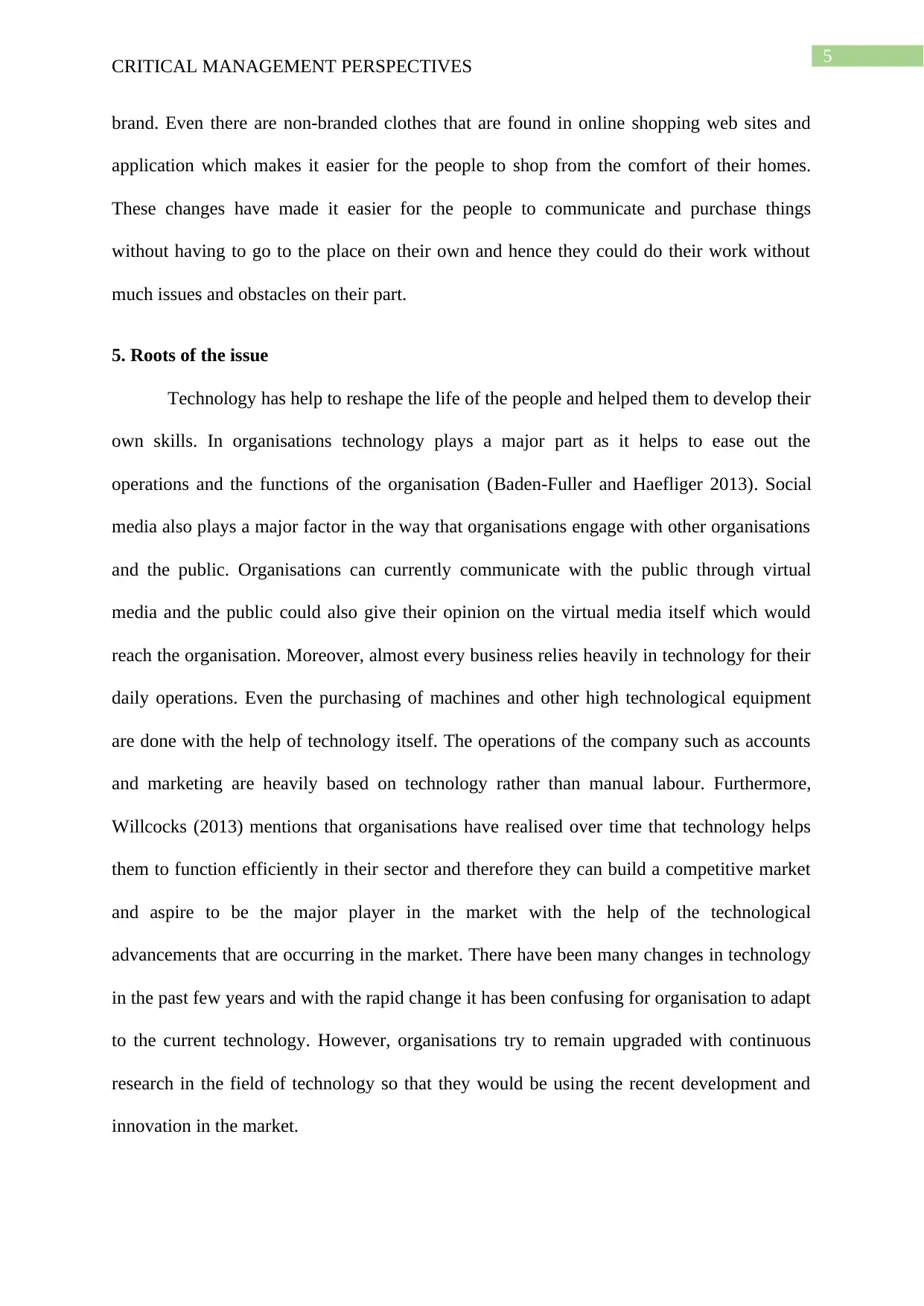
5
CRITICAL MANAGEMENT PERSPECTIVES
brand. Even there are non-branded clothes that are found in online shopping web sites and
application which makes it easier for the people to shop from the comfort of their homes.
These changes have made it easier for the people to communicate and purchase things
without having to go to the place on their own and hence they could do their work without
much issues and obstacles on their part.
5. Roots of the issue
Technology has help to reshape the life of the people and helped them to develop their
own skills. In organisations technology plays a major part as it helps to ease out the
operations and the functions of the organisation (Baden-Fuller and Haefliger 2013). Social
media also plays a major factor in the way that organisations engage with other organisations
and the public. Organisations can currently communicate with the public through virtual
media and the public could also give their opinion on the virtual media itself which would
reach the organisation. Moreover, almost every business relies heavily in technology for their
daily operations. Even the purchasing of machines and other high technological equipment
are done with the help of technology itself. The operations of the company such as accounts
and marketing are heavily based on technology rather than manual labour. Furthermore,
Willcocks (2013) mentions that organisations have realised over time that technology helps
them to function efficiently in their sector and therefore they can build a competitive market
and aspire to be the major player in the market with the help of the technological
advancements that are occurring in the market. There have been many changes in technology
in the past few years and with the rapid change it has been confusing for organisation to adapt
to the current technology. However, organisations try to remain upgraded with continuous
research in the field of technology so that they would be using the recent development and
innovation in the market.
CRITICAL MANAGEMENT PERSPECTIVES
brand. Even there are non-branded clothes that are found in online shopping web sites and
application which makes it easier for the people to shop from the comfort of their homes.
These changes have made it easier for the people to communicate and purchase things
without having to go to the place on their own and hence they could do their work without
much issues and obstacles on their part.
5. Roots of the issue
Technology has help to reshape the life of the people and helped them to develop their
own skills. In organisations technology plays a major part as it helps to ease out the
operations and the functions of the organisation (Baden-Fuller and Haefliger 2013). Social
media also plays a major factor in the way that organisations engage with other organisations
and the public. Organisations can currently communicate with the public through virtual
media and the public could also give their opinion on the virtual media itself which would
reach the organisation. Moreover, almost every business relies heavily in technology for their
daily operations. Even the purchasing of machines and other high technological equipment
are done with the help of technology itself. The operations of the company such as accounts
and marketing are heavily based on technology rather than manual labour. Furthermore,
Willcocks (2013) mentions that organisations have realised over time that technology helps
them to function efficiently in their sector and therefore they can build a competitive market
and aspire to be the major player in the market with the help of the technological
advancements that are occurring in the market. There have been many changes in technology
in the past few years and with the rapid change it has been confusing for organisation to adapt
to the current technology. However, organisations try to remain upgraded with continuous
research in the field of technology so that they would be using the recent development and
innovation in the market.
⊘ This is a preview!⊘
Do you want full access?
Subscribe today to unlock all pages.

Trusted by 1+ million students worldwide
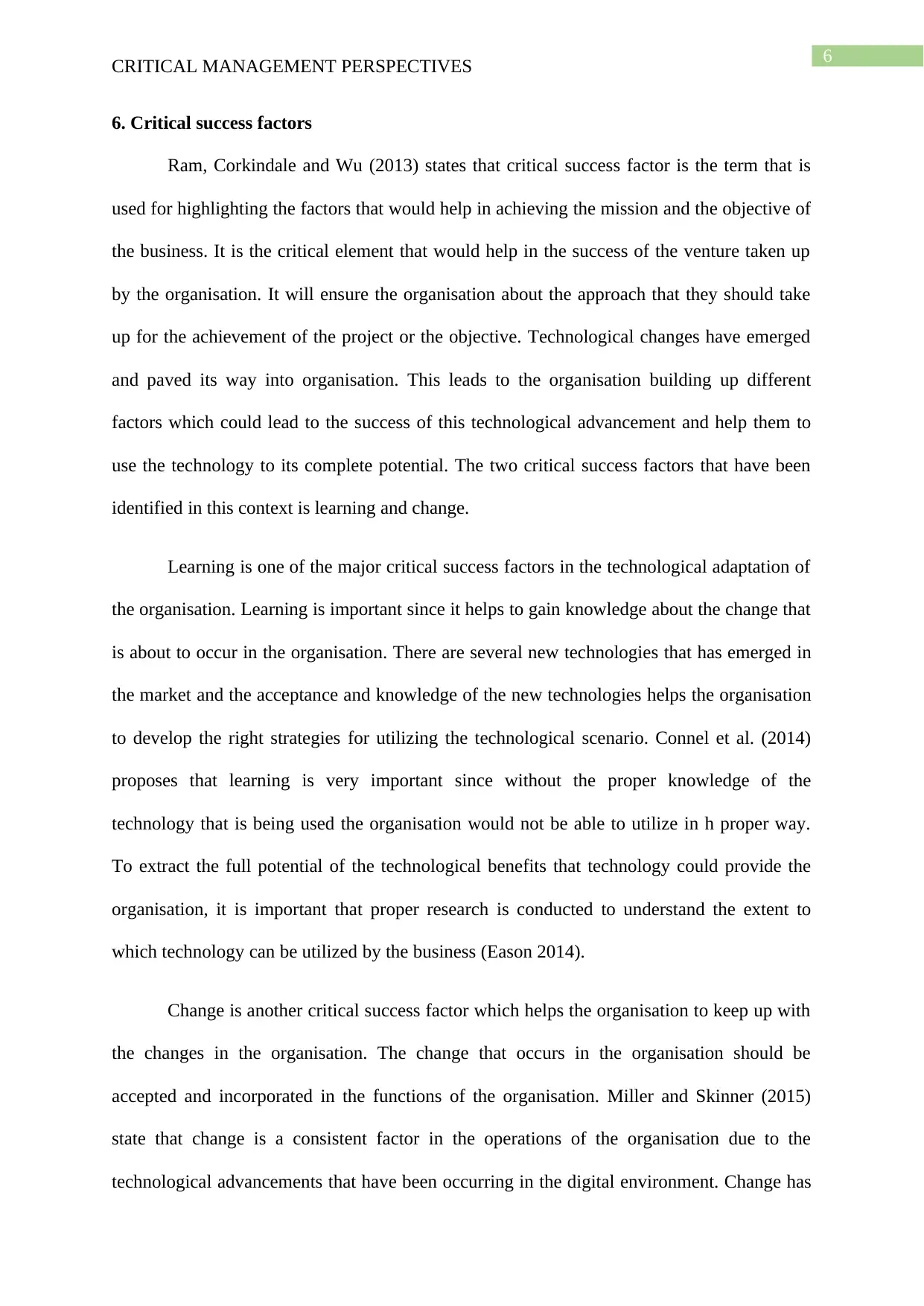
6
CRITICAL MANAGEMENT PERSPECTIVES
6. Critical success factors
Ram, Corkindale and Wu (2013) states that critical success factor is the term that is
used for highlighting the factors that would help in achieving the mission and the objective of
the business. It is the critical element that would help in the success of the venture taken up
by the organisation. It will ensure the organisation about the approach that they should take
up for the achievement of the project or the objective. Technological changes have emerged
and paved its way into organisation. This leads to the organisation building up different
factors which could lead to the success of this technological advancement and help them to
use the technology to its complete potential. The two critical success factors that have been
identified in this context is learning and change.
Learning is one of the major critical success factors in the technological adaptation of
the organisation. Learning is important since it helps to gain knowledge about the change that
is about to occur in the organisation. There are several new technologies that has emerged in
the market and the acceptance and knowledge of the new technologies helps the organisation
to develop the right strategies for utilizing the technological scenario. Connel et al. (2014)
proposes that learning is very important since without the proper knowledge of the
technology that is being used the organisation would not be able to utilize in h proper way.
To extract the full potential of the technological benefits that technology could provide the
organisation, it is important that proper research is conducted to understand the extent to
which technology can be utilized by the business (Eason 2014).
Change is another critical success factor which helps the organisation to keep up with
the changes in the organisation. The change that occurs in the organisation should be
accepted and incorporated in the functions of the organisation. Miller and Skinner (2015)
state that change is a consistent factor in the operations of the organisation due to the
technological advancements that have been occurring in the digital environment. Change has
CRITICAL MANAGEMENT PERSPECTIVES
6. Critical success factors
Ram, Corkindale and Wu (2013) states that critical success factor is the term that is
used for highlighting the factors that would help in achieving the mission and the objective of
the business. It is the critical element that would help in the success of the venture taken up
by the organisation. It will ensure the organisation about the approach that they should take
up for the achievement of the project or the objective. Technological changes have emerged
and paved its way into organisation. This leads to the organisation building up different
factors which could lead to the success of this technological advancement and help them to
use the technology to its complete potential. The two critical success factors that have been
identified in this context is learning and change.
Learning is one of the major critical success factors in the technological adaptation of
the organisation. Learning is important since it helps to gain knowledge about the change that
is about to occur in the organisation. There are several new technologies that has emerged in
the market and the acceptance and knowledge of the new technologies helps the organisation
to develop the right strategies for utilizing the technological scenario. Connel et al. (2014)
proposes that learning is very important since without the proper knowledge of the
technology that is being used the organisation would not be able to utilize in h proper way.
To extract the full potential of the technological benefits that technology could provide the
organisation, it is important that proper research is conducted to understand the extent to
which technology can be utilized by the business (Eason 2014).
Change is another critical success factor which helps the organisation to keep up with
the changes in the organisation. The change that occurs in the organisation should be
accepted and incorporated in the functions of the organisation. Miller and Skinner (2015)
state that change is a consistent factor in the operations of the organisation due to the
technological advancements that have been occurring in the digital environment. Change has
Paraphrase This Document
Need a fresh take? Get an instant paraphrase of this document with our AI Paraphraser
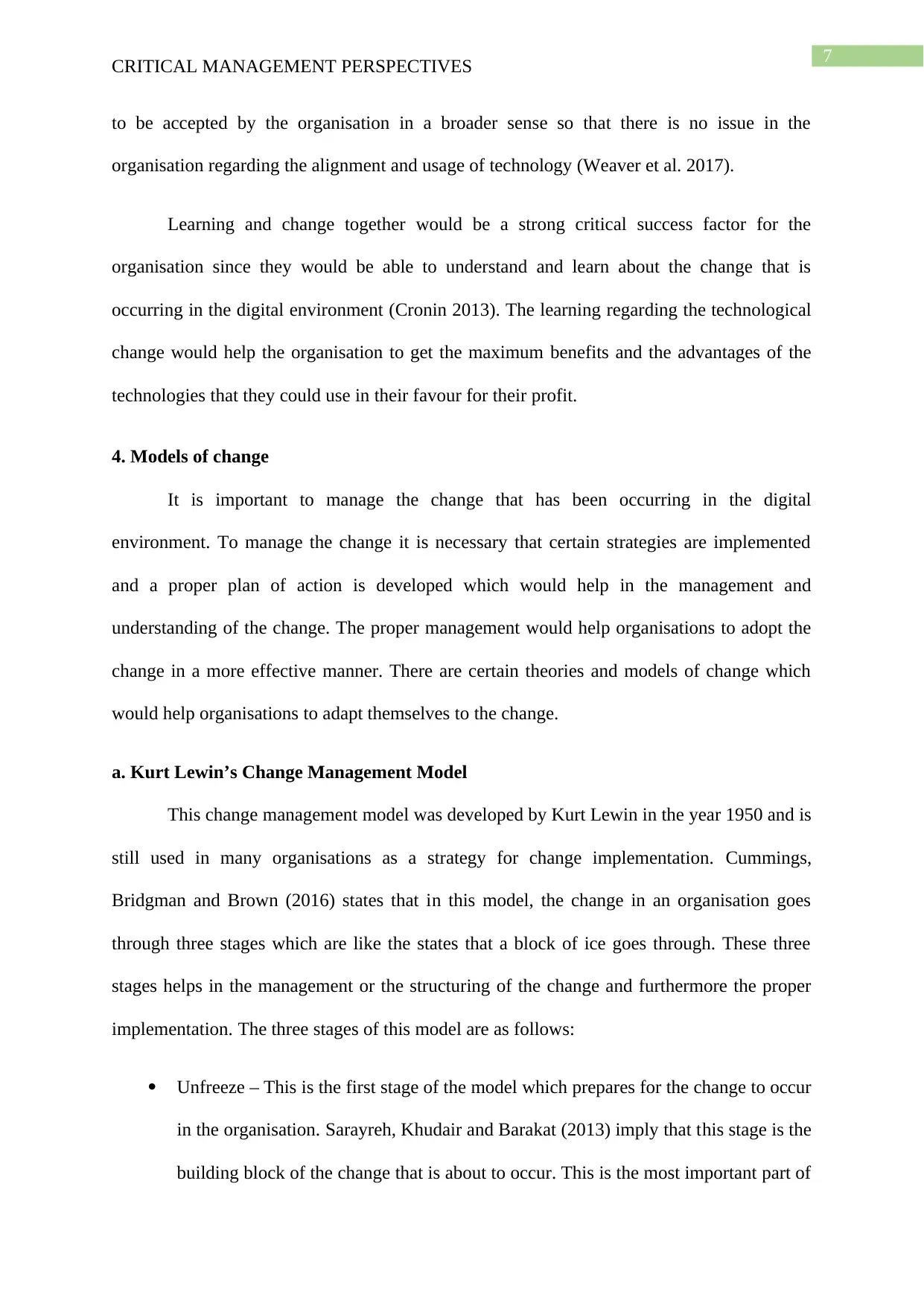
7
CRITICAL MANAGEMENT PERSPECTIVES
to be accepted by the organisation in a broader sense so that there is no issue in the
organisation regarding the alignment and usage of technology (Weaver et al. 2017).
Learning and change together would be a strong critical success factor for the
organisation since they would be able to understand and learn about the change that is
occurring in the digital environment (Cronin 2013). The learning regarding the technological
change would help the organisation to get the maximum benefits and the advantages of the
technologies that they could use in their favour for their profit.
4. Models of change
It is important to manage the change that has been occurring in the digital
environment. To manage the change it is necessary that certain strategies are implemented
and a proper plan of action is developed which would help in the management and
understanding of the change. The proper management would help organisations to adopt the
change in a more effective manner. There are certain theories and models of change which
would help organisations to adapt themselves to the change.
a. Kurt Lewin’s Change Management Model
This change management model was developed by Kurt Lewin in the year 1950 and is
still used in many organisations as a strategy for change implementation. Cummings,
Bridgman and Brown (2016) states that in this model, the change in an organisation goes
through three stages which are like the states that a block of ice goes through. These three
stages helps in the management or the structuring of the change and furthermore the proper
implementation. The three stages of this model are as follows:
Unfreeze – This is the first stage of the model which prepares for the change to occur
in the organisation. Sarayreh, Khudair and Barakat (2013) imply that this stage is the
building block of the change that is about to occur. This is the most important part of
CRITICAL MANAGEMENT PERSPECTIVES
to be accepted by the organisation in a broader sense so that there is no issue in the
organisation regarding the alignment and usage of technology (Weaver et al. 2017).
Learning and change together would be a strong critical success factor for the
organisation since they would be able to understand and learn about the change that is
occurring in the digital environment (Cronin 2013). The learning regarding the technological
change would help the organisation to get the maximum benefits and the advantages of the
technologies that they could use in their favour for their profit.
4. Models of change
It is important to manage the change that has been occurring in the digital
environment. To manage the change it is necessary that certain strategies are implemented
and a proper plan of action is developed which would help in the management and
understanding of the change. The proper management would help organisations to adopt the
change in a more effective manner. There are certain theories and models of change which
would help organisations to adapt themselves to the change.
a. Kurt Lewin’s Change Management Model
This change management model was developed by Kurt Lewin in the year 1950 and is
still used in many organisations as a strategy for change implementation. Cummings,
Bridgman and Brown (2016) states that in this model, the change in an organisation goes
through three stages which are like the states that a block of ice goes through. These three
stages helps in the management or the structuring of the change and furthermore the proper
implementation. The three stages of this model are as follows:
Unfreeze – This is the first stage of the model which prepares for the change to occur
in the organisation. Sarayreh, Khudair and Barakat (2013) imply that this stage is the
building block of the change that is about to occur. This is the most important part of
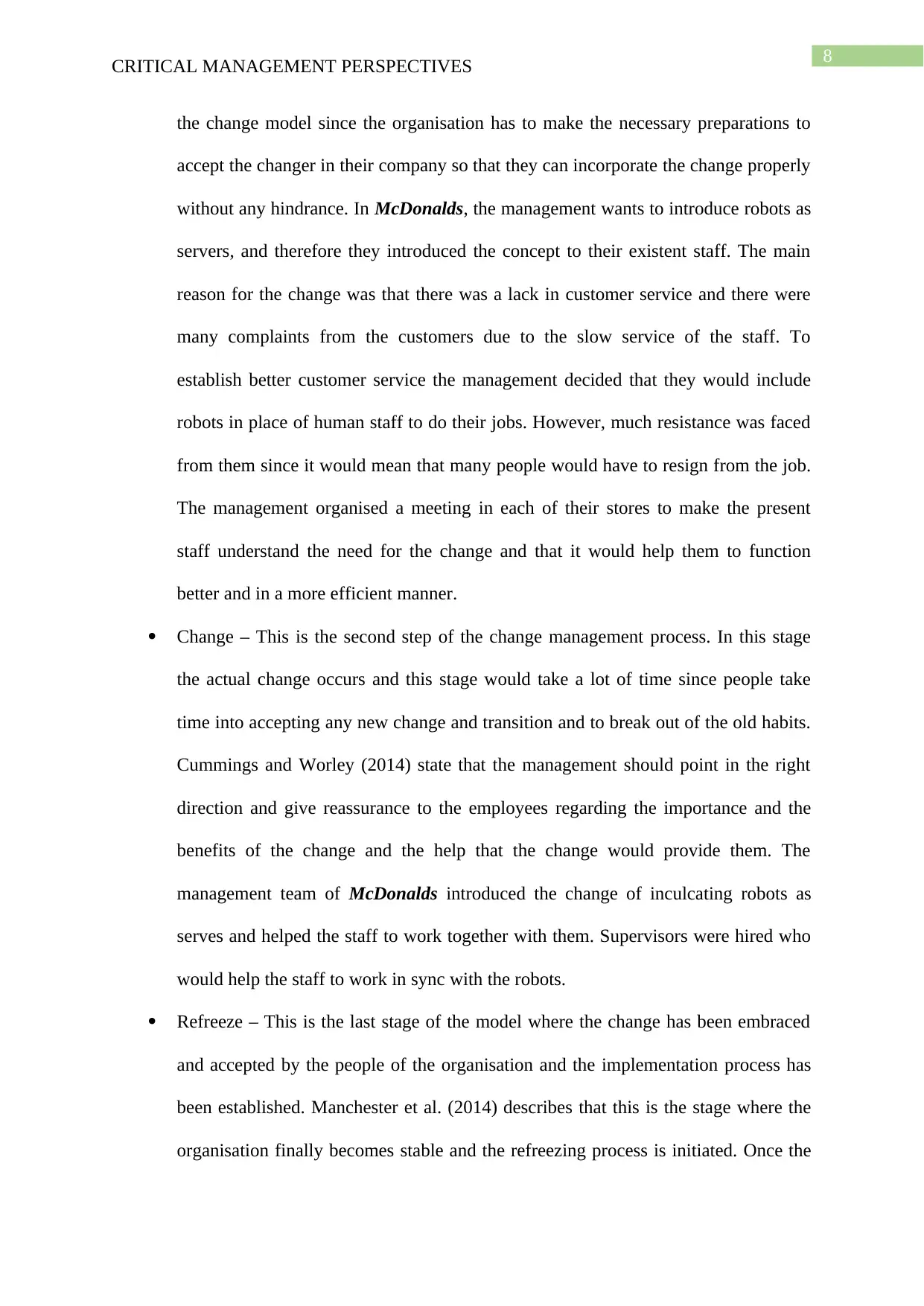
8
CRITICAL MANAGEMENT PERSPECTIVES
the change model since the organisation has to make the necessary preparations to
accept the changer in their company so that they can incorporate the change properly
without any hindrance. In McDonalds, the management wants to introduce robots as
servers, and therefore they introduced the concept to their existent staff. The main
reason for the change was that there was a lack in customer service and there were
many complaints from the customers due to the slow service of the staff. To
establish better customer service the management decided that they would include
robots in place of human staff to do their jobs. However, much resistance was faced
from them since it would mean that many people would have to resign from the job.
The management organised a meeting in each of their stores to make the present
staff understand the need for the change and that it would help them to function
better and in a more efficient manner.
Change – This is the second step of the change management process. In this stage
the actual change occurs and this stage would take a lot of time since people take
time into accepting any new change and transition and to break out of the old habits.
Cummings and Worley (2014) state that the management should point in the right
direction and give reassurance to the employees regarding the importance and the
benefits of the change and the help that the change would provide them. The
management team of McDonalds introduced the change of inculcating robots as
serves and helped the staff to work together with them. Supervisors were hired who
would help the staff to work in sync with the robots.
Refreeze – This is the last stage of the model where the change has been embraced
and accepted by the people of the organisation and the implementation process has
been established. Manchester et al. (2014) describes that this is the stage where the
organisation finally becomes stable and the refreezing process is initiated. Once the
CRITICAL MANAGEMENT PERSPECTIVES
the change model since the organisation has to make the necessary preparations to
accept the changer in their company so that they can incorporate the change properly
without any hindrance. In McDonalds, the management wants to introduce robots as
servers, and therefore they introduced the concept to their existent staff. The main
reason for the change was that there was a lack in customer service and there were
many complaints from the customers due to the slow service of the staff. To
establish better customer service the management decided that they would include
robots in place of human staff to do their jobs. However, much resistance was faced
from them since it would mean that many people would have to resign from the job.
The management organised a meeting in each of their stores to make the present
staff understand the need for the change and that it would help them to function
better and in a more efficient manner.
Change – This is the second step of the change management process. In this stage
the actual change occurs and this stage would take a lot of time since people take
time into accepting any new change and transition and to break out of the old habits.
Cummings and Worley (2014) state that the management should point in the right
direction and give reassurance to the employees regarding the importance and the
benefits of the change and the help that the change would provide them. The
management team of McDonalds introduced the change of inculcating robots as
serves and helped the staff to work together with them. Supervisors were hired who
would help the staff to work in sync with the robots.
Refreeze – This is the last stage of the model where the change has been embraced
and accepted by the people of the organisation and the implementation process has
been established. Manchester et al. (2014) describes that this is the stage where the
organisation finally becomes stable and the refreezing process is initiated. Once the
⊘ This is a preview!⊘
Do you want full access?
Subscribe today to unlock all pages.

Trusted by 1+ million students worldwide
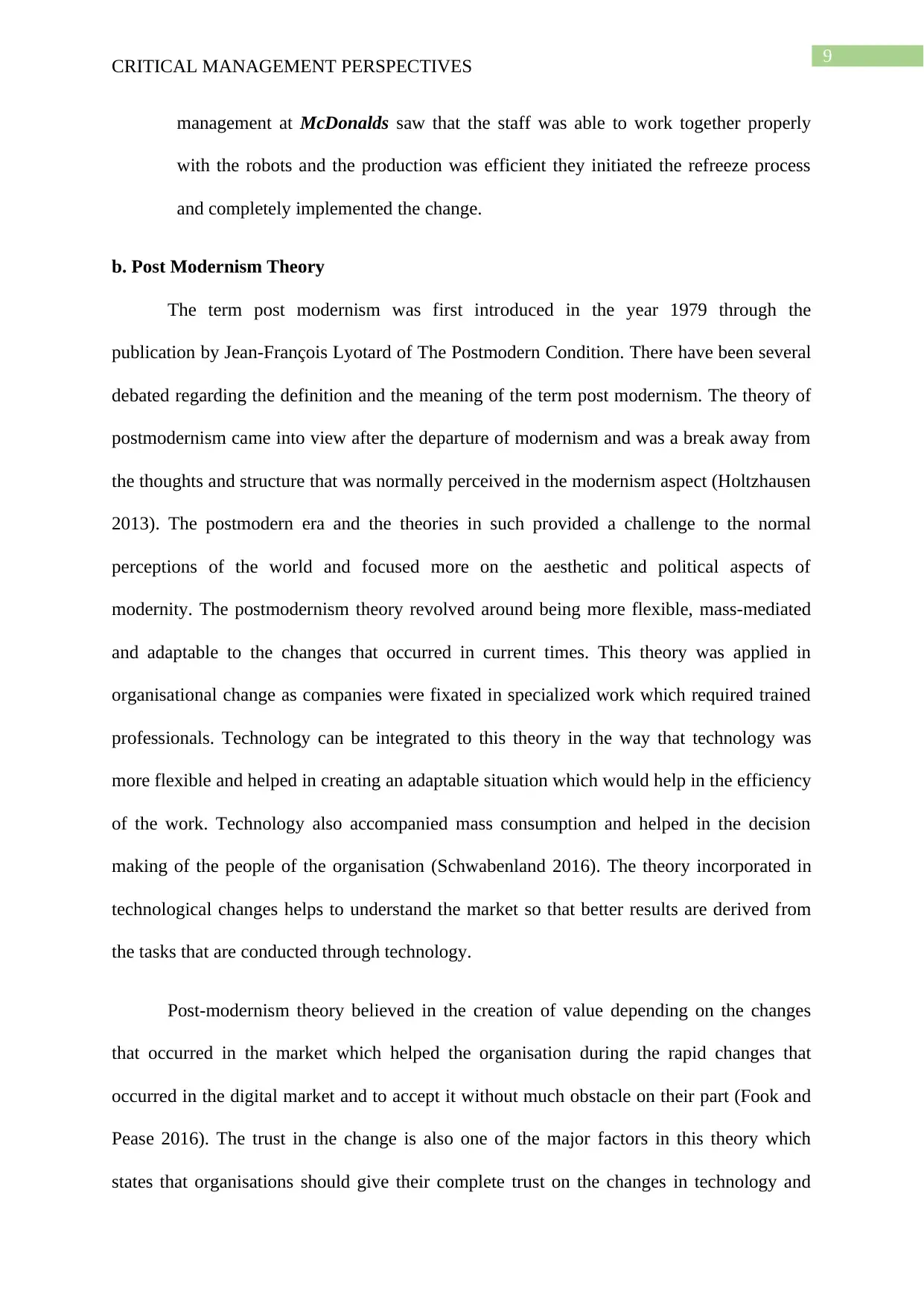
9
CRITICAL MANAGEMENT PERSPECTIVES
management at McDonalds saw that the staff was able to work together properly
with the robots and the production was efficient they initiated the refreeze process
and completely implemented the change.
b. Post Modernism Theory
The term post modernism was first introduced in the year 1979 through the
publication by Jean-François Lyotard of The Postmodern Condition. There have been several
debated regarding the definition and the meaning of the term post modernism. The theory of
postmodernism came into view after the departure of modernism and was a break away from
the thoughts and structure that was normally perceived in the modernism aspect (Holtzhausen
2013). The postmodern era and the theories in such provided a challenge to the normal
perceptions of the world and focused more on the aesthetic and political aspects of
modernity. The postmodernism theory revolved around being more flexible, mass-mediated
and adaptable to the changes that occurred in current times. This theory was applied in
organisational change as companies were fixated in specialized work which required trained
professionals. Technology can be integrated to this theory in the way that technology was
more flexible and helped in creating an adaptable situation which would help in the efficiency
of the work. Technology also accompanied mass consumption and helped in the decision
making of the people of the organisation (Schwabenland 2016). The theory incorporated in
technological changes helps to understand the market so that better results are derived from
the tasks that are conducted through technology.
Post-modernism theory believed in the creation of value depending on the changes
that occurred in the market which helped the organisation during the rapid changes that
occurred in the digital market and to accept it without much obstacle on their part (Fook and
Pease 2016). The trust in the change is also one of the major factors in this theory which
states that organisations should give their complete trust on the changes in technology and
CRITICAL MANAGEMENT PERSPECTIVES
management at McDonalds saw that the staff was able to work together properly
with the robots and the production was efficient they initiated the refreeze process
and completely implemented the change.
b. Post Modernism Theory
The term post modernism was first introduced in the year 1979 through the
publication by Jean-François Lyotard of The Postmodern Condition. There have been several
debated regarding the definition and the meaning of the term post modernism. The theory of
postmodernism came into view after the departure of modernism and was a break away from
the thoughts and structure that was normally perceived in the modernism aspect (Holtzhausen
2013). The postmodern era and the theories in such provided a challenge to the normal
perceptions of the world and focused more on the aesthetic and political aspects of
modernity. The postmodernism theory revolved around being more flexible, mass-mediated
and adaptable to the changes that occurred in current times. This theory was applied in
organisational change as companies were fixated in specialized work which required trained
professionals. Technology can be integrated to this theory in the way that technology was
more flexible and helped in creating an adaptable situation which would help in the efficiency
of the work. Technology also accompanied mass consumption and helped in the decision
making of the people of the organisation (Schwabenland 2016). The theory incorporated in
technological changes helps to understand the market so that better results are derived from
the tasks that are conducted through technology.
Post-modernism theory believed in the creation of value depending on the changes
that occurred in the market which helped the organisation during the rapid changes that
occurred in the digital market and to accept it without much obstacle on their part (Fook and
Pease 2016). The trust in the change is also one of the major factors in this theory which
states that organisations should give their complete trust on the changes in technology and
Paraphrase This Document
Need a fresh take? Get an instant paraphrase of this document with our AI Paraphraser
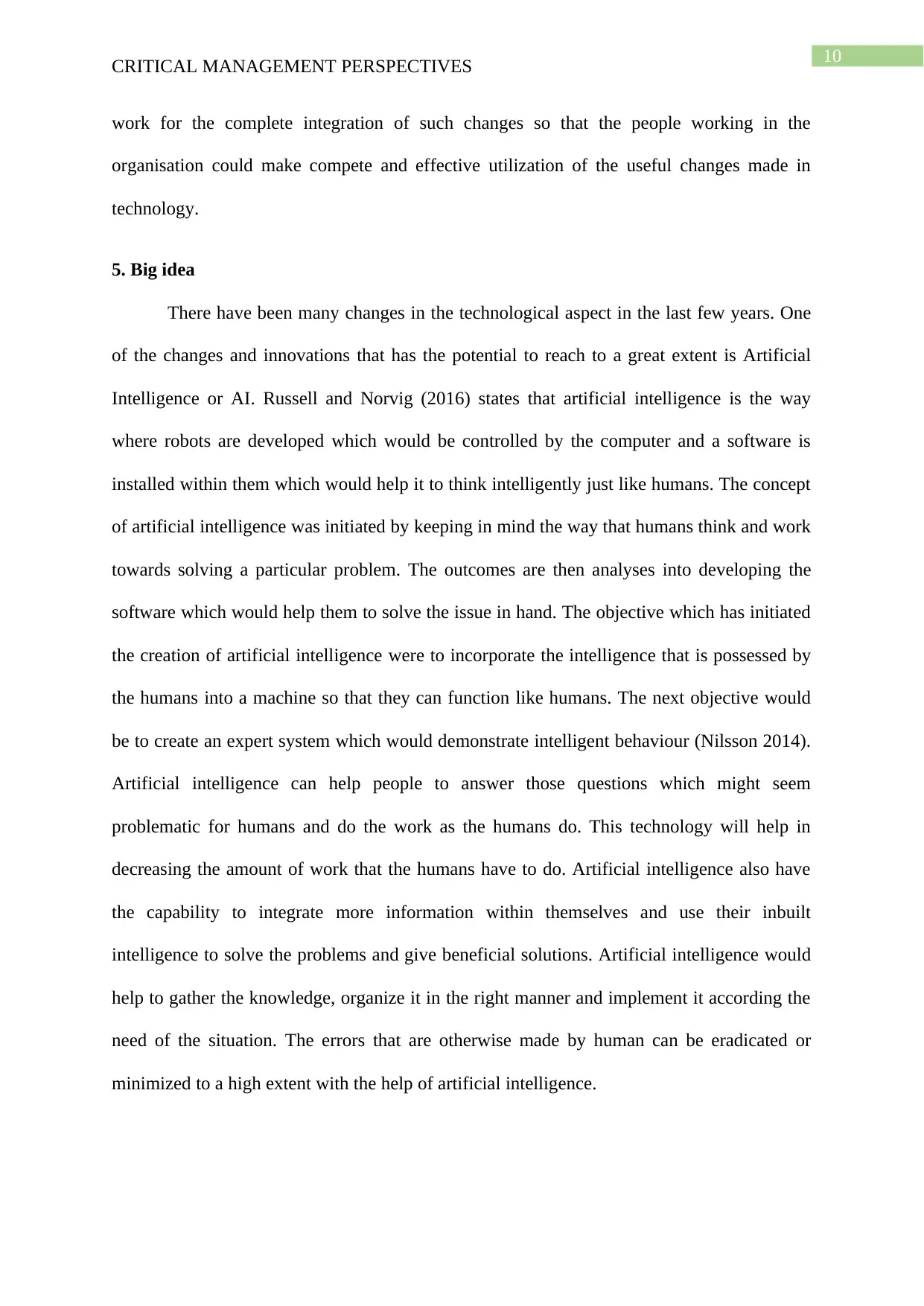
10
CRITICAL MANAGEMENT PERSPECTIVES
work for the complete integration of such changes so that the people working in the
organisation could make compete and effective utilization of the useful changes made in
technology.
5. Big idea
There have been many changes in the technological aspect in the last few years. One
of the changes and innovations that has the potential to reach to a great extent is Artificial
Intelligence or AI. Russell and Norvig (2016) states that artificial intelligence is the way
where robots are developed which would be controlled by the computer and a software is
installed within them which would help it to think intelligently just like humans. The concept
of artificial intelligence was initiated by keeping in mind the way that humans think and work
towards solving a particular problem. The outcomes are then analyses into developing the
software which would help them to solve the issue in hand. The objective which has initiated
the creation of artificial intelligence were to incorporate the intelligence that is possessed by
the humans into a machine so that they can function like humans. The next objective would
be to create an expert system which would demonstrate intelligent behaviour (Nilsson 2014).
Artificial intelligence can help people to answer those questions which might seem
problematic for humans and do the work as the humans do. This technology will help in
decreasing the amount of work that the humans have to do. Artificial intelligence also have
the capability to integrate more information within themselves and use their inbuilt
intelligence to solve the problems and give beneficial solutions. Artificial intelligence would
help to gather the knowledge, organize it in the right manner and implement it according the
need of the situation. The errors that are otherwise made by human can be eradicated or
minimized to a high extent with the help of artificial intelligence.
CRITICAL MANAGEMENT PERSPECTIVES
work for the complete integration of such changes so that the people working in the
organisation could make compete and effective utilization of the useful changes made in
technology.
5. Big idea
There have been many changes in the technological aspect in the last few years. One
of the changes and innovations that has the potential to reach to a great extent is Artificial
Intelligence or AI. Russell and Norvig (2016) states that artificial intelligence is the way
where robots are developed which would be controlled by the computer and a software is
installed within them which would help it to think intelligently just like humans. The concept
of artificial intelligence was initiated by keeping in mind the way that humans think and work
towards solving a particular problem. The outcomes are then analyses into developing the
software which would help them to solve the issue in hand. The objective which has initiated
the creation of artificial intelligence were to incorporate the intelligence that is possessed by
the humans into a machine so that they can function like humans. The next objective would
be to create an expert system which would demonstrate intelligent behaviour (Nilsson 2014).
Artificial intelligence can help people to answer those questions which might seem
problematic for humans and do the work as the humans do. This technology will help in
decreasing the amount of work that the humans have to do. Artificial intelligence also have
the capability to integrate more information within themselves and use their inbuilt
intelligence to solve the problems and give beneficial solutions. Artificial intelligence would
help to gather the knowledge, organize it in the right manner and implement it according the
need of the situation. The errors that are otherwise made by human can be eradicated or
minimized to a high extent with the help of artificial intelligence.
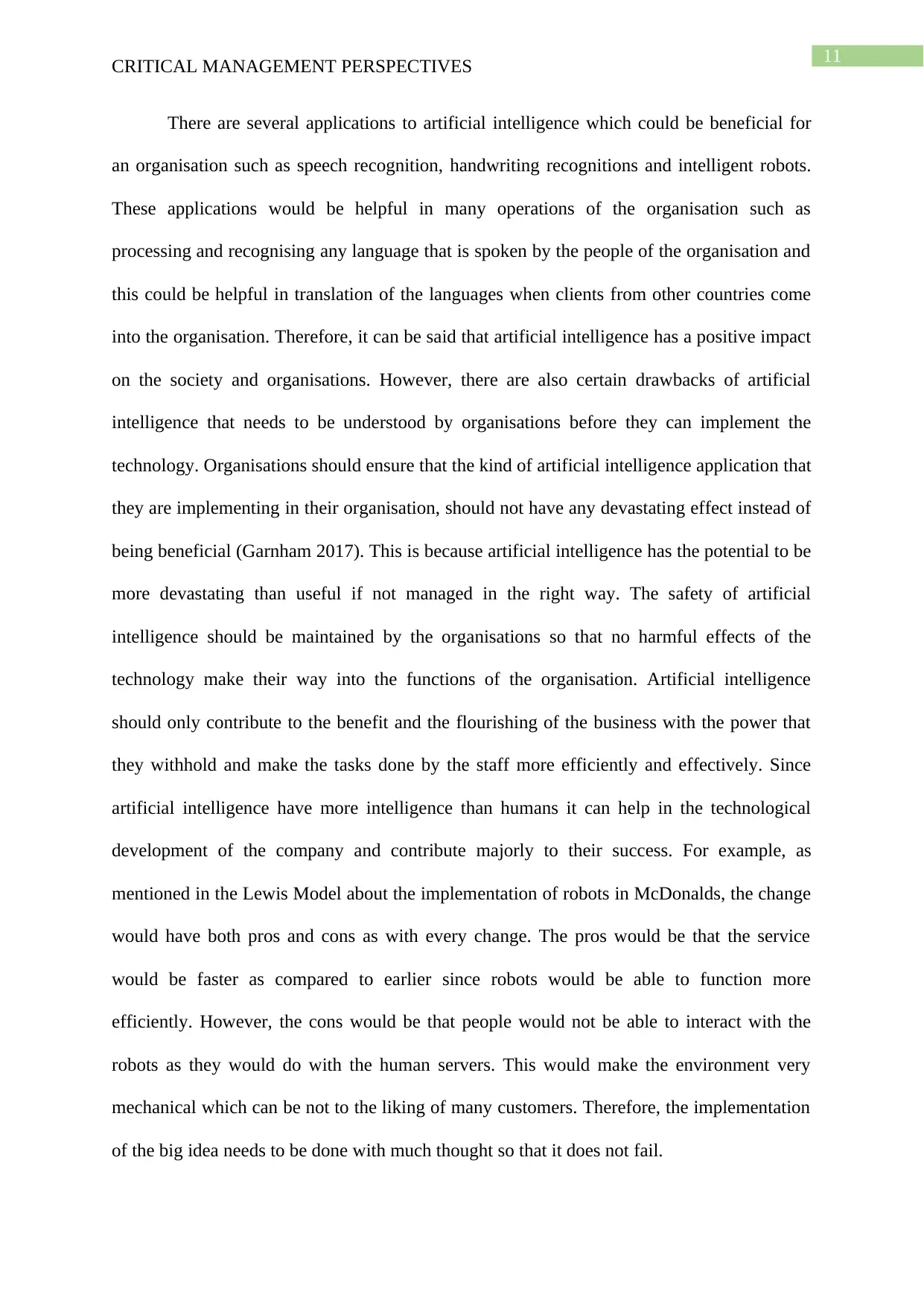
11
CRITICAL MANAGEMENT PERSPECTIVES
There are several applications to artificial intelligence which could be beneficial for
an organisation such as speech recognition, handwriting recognitions and intelligent robots.
These applications would be helpful in many operations of the organisation such as
processing and recognising any language that is spoken by the people of the organisation and
this could be helpful in translation of the languages when clients from other countries come
into the organisation. Therefore, it can be said that artificial intelligence has a positive impact
on the society and organisations. However, there are also certain drawbacks of artificial
intelligence that needs to be understood by organisations before they can implement the
technology. Organisations should ensure that the kind of artificial intelligence application that
they are implementing in their organisation, should not have any devastating effect instead of
being beneficial (Garnham 2017). This is because artificial intelligence has the potential to be
more devastating than useful if not managed in the right way. The safety of artificial
intelligence should be maintained by the organisations so that no harmful effects of the
technology make their way into the functions of the organisation. Artificial intelligence
should only contribute to the benefit and the flourishing of the business with the power that
they withhold and make the tasks done by the staff more efficiently and effectively. Since
artificial intelligence have more intelligence than humans it can help in the technological
development of the company and contribute majorly to their success. For example, as
mentioned in the Lewis Model about the implementation of robots in McDonalds, the change
would have both pros and cons as with every change. The pros would be that the service
would be faster as compared to earlier since robots would be able to function more
efficiently. However, the cons would be that people would not be able to interact with the
robots as they would do with the human servers. This would make the environment very
mechanical which can be not to the liking of many customers. Therefore, the implementation
of the big idea needs to be done with much thought so that it does not fail.
CRITICAL MANAGEMENT PERSPECTIVES
There are several applications to artificial intelligence which could be beneficial for
an organisation such as speech recognition, handwriting recognitions and intelligent robots.
These applications would be helpful in many operations of the organisation such as
processing and recognising any language that is spoken by the people of the organisation and
this could be helpful in translation of the languages when clients from other countries come
into the organisation. Therefore, it can be said that artificial intelligence has a positive impact
on the society and organisations. However, there are also certain drawbacks of artificial
intelligence that needs to be understood by organisations before they can implement the
technology. Organisations should ensure that the kind of artificial intelligence application that
they are implementing in their organisation, should not have any devastating effect instead of
being beneficial (Garnham 2017). This is because artificial intelligence has the potential to be
more devastating than useful if not managed in the right way. The safety of artificial
intelligence should be maintained by the organisations so that no harmful effects of the
technology make their way into the functions of the organisation. Artificial intelligence
should only contribute to the benefit and the flourishing of the business with the power that
they withhold and make the tasks done by the staff more efficiently and effectively. Since
artificial intelligence have more intelligence than humans it can help in the technological
development of the company and contribute majorly to their success. For example, as
mentioned in the Lewis Model about the implementation of robots in McDonalds, the change
would have both pros and cons as with every change. The pros would be that the service
would be faster as compared to earlier since robots would be able to function more
efficiently. However, the cons would be that people would not be able to interact with the
robots as they would do with the human servers. This would make the environment very
mechanical which can be not to the liking of many customers. Therefore, the implementation
of the big idea needs to be done with much thought so that it does not fail.
⊘ This is a preview!⊘
Do you want full access?
Subscribe today to unlock all pages.

Trusted by 1+ million students worldwide
1 out of 16
Related Documents
Your All-in-One AI-Powered Toolkit for Academic Success.
+13062052269
info@desklib.com
Available 24*7 on WhatsApp / Email
![[object Object]](/_next/static/media/star-bottom.7253800d.svg)
Unlock your academic potential
Copyright © 2020–2025 A2Z Services. All Rights Reserved. Developed and managed by ZUCOL.





